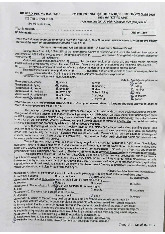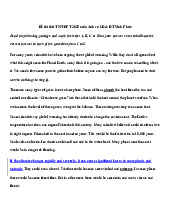



















Preview text:
Đề thi thử THPT Quốc gia môn tiếng Anh 2025 có đáp án
Read the following passage and mark the letter A, B, C and D on your answer sheet to
indicate the option that best fits each of the numbered blanks from 1 to 6.
Japan’s Cherry Blossom Festival, Hanami, is a traditional celebration ___(1)___ during spring.
It involves the viewing of cherry blossoms, known as sakura, which bloom at different times
across Japan. The festival typically starts in late March and continues ___(2)___ approximately
2 weeks. Celebrations include outdoor parties, picnics, and events in public parks, rivers, and
other locations where cherry trees are ___(3)___. The festival dates back to the Nara period
(710-794 A.D.), indicating its ___(4)___ in Japan. The cherry blossoms symbolize the arrival of
spring and the transient beauty of nature. The short blooming period of the sakura is a reminder
of life’s fleeting ___(5)___. This festival is not just about viewing flowers, but it’s a time for
people ___(6)___ together and appreciate the simple, yet transient beauty of life. Question 1. A. which held B. is held C. holding D. held Question 2. A. by B. for C. in D. with Question 3. A. given B. found C. sent D. grown
Question 4. A. cultural deep significance B. cultural significance deep C. deep cultural significance D. significance deep cultural Question 5. A. beauty B. beautify C. beautiful D. beautifully Question 6. A. coming B. come C. to come D. to coming
Read the following announcement and mark the letter A, B, C or D on your answer sheet
to indicate the option that best fits each of the numbered blanks from 7 to 12.
Title: ASEAN poster making event
To: The Hanoi High School Youth Union Board Date: 10 January 2024
We would like to propose an ASEAN poster making event to welcome a ___(7)___ of students
from ASEAN countries who are coming to visit our school on 3rd of March.
The event will take place in the school Hall from 9 a.m. until 5 p.m. We will organise all the
activities and invite all ASEAN students and representatives of ___(8)___ classes. In the
morning, students will take part in training ___(9)___ on poster design, presentations and
discussions on current issues in ASEAN, and group brainstorming activities. We’ll also
___(10)___ packed lunch boxes to be delivered at 1 p.m. so participants can eat in the school
hall. In the afternoon, the teams will make their posters.
The event will help young people from ASEAN countries meet and build a community.
Participants will also have a chance to learn about each other’s culture. We believe that the event
will help develop students’ ability to work with people from other countries and create shared ___(11)___.
We really hope you will consider our proposal ___(12)___ we think that it will be beneficial to
both local students and the visiting ASEAN students. Question 7. A. group B. variety C. amount D. level Question 8. A. others B. other C. another D. the others
Question 9. A. workshops B. conferences C. anniversaries D. interviews
Question 10. A. care about B. depend on C. respond to D. arrange for Question 11. A. customs B. values C. units D. ideas Question 12. A. as B. athough C. yet D. though
Mark the letter A, B, C or D on your answer sheet to indicate the best arrangement of
utterances or sentences to make a meaningful exchange or text in each of the following
questions from 13 to 17. Question 13.
a. Jane: Watch out! You're too close and will burn yourself!
b. Jane: Hi, Nga. Is that a coal-burning stove?
c. Nga: Hi. Yes, my dad bought it last week. It heats up our home very quickly. Let me put in some more coal. A. c-b-a B. a-c-b C. c-a-b D. b-c-a Question 14.
a. Mike: I went to India for two weeks. b. Sue: No. What happened?
c. Mike: I felt as if I was a fish out of water.
d. Mike: Hey, have I ever told you about the time I traveled alone? e. Sue: How did you feel? A. d-e-a-b-c B. d-b-a-e-c C. c-b-a-e-d D. c-e-d-b-a Question 15. Dear Alex,
a. However, if you could let us know which area you are most interested in and why, we can
make sure we won’t disappoint you.
b. Thank you for your email. It sounds like you would be perfect for the course.
c. Looking forward to your reply.
d. It would also be helpful to know if there is any food you don’t eat. This will make life easier for our cook.
e. We offer lessons in all types of art. Best wishes, Hillary Mason A. b-e-a-d-c B. d-b-a-c-e C. a-c-d-b-e D. a-d-b-c-e Question 16.
a. After completing my degree in social work, I began working as a social worker and have been
doing it for almost five years now.
b. My advice to anyone who is considering a career in social work is to have a strong support
system in place and take care of yourself mentally and physically.
c. It can be emotionally challenging at times, but the reward of seeing people's lives change for
the better is what keeps me motivated to work hard every day.
d. I have always been passionate about helping others in my community.
e. I always try to make a positive difference in someone's life, no matter how small it may be.
Knowing that I am able to make a positive impact on someone's life makes me feel good. A. c-a-d-e-b B. e-c-d-a-b C. a-e-c-d-b D. d-a-c-e-b Question 17.
a. Urbanization is rapidly replacing parks with buildings, which threatens air quality and animal habitats.
b. Additionally, we advocate for new laws to protect existing parks. You can support us through donations or volunteering.
c. If you want to volunteer or donate money to Park Protectors, visit www.parkprotectors.com to
learn more and join our mission to save parks and wildlife.
d. Park Protectors is an environmental charity working in over 15 countries to create and
preserve parks for both people and animals.
e. We run campaigns to protect these green spaces: one focuses on fundraising to build new
parks, and another organizes protests against companies planning to develop on parkland. A. d-e-b-c-a B. d-c-a-b-e C. d-a-e-b-c D. d-b-a-e-c
Read the following passage about science of love and mark the letter A, B, C or D on your
answer sheet to indicate the option that best fits each of the numbered blanks from 18 to 22.
Although couples will rarely believe it, scientific factors ___(18)___. Research has shown that
scent plays an important role in choosing a mate. Other experiments have demonstrated that love
is caused by combinations of chemicals in the brain. Furthermore, New York psychologist
Arthur Aron applied the principles of science to demonstrate that the process of falling in love
could be speeded up to just 45 minutes!
___(19)___. However, the leap from being attracted to someone to falling in love with them is a
big one, and Aron wanted to find out if the closeness associated with feelings of being in love could be created artificially.
Aron produced a paper ___(20)___. if couples answered them together. The questions came in
three sets with each set covering increasingly intimate ground. They covered many personal
opinions and experiences; for example, 'Would you like to be famous?", 'What does friendship
mean to you?" and 'When did you last cry in front of another person?" After answering the
questions together, ___(21)___.
Aron tested his questions on pairs of strangers and then asked them to stare at each other.
___(22)___. Many of them swapped contact details after the experiment. So if you're keen on
someone and would like to get closer to them, it would seem that Aron's questions could help you to achieve your objective. Question 18.
A. that have a lot to do with falling for someone
B. having affected a person being in love
C. have a lot to do with falling in love
D. by which a person falling in love is affected Question 19.
A. Whether we like someone or not is claimed by some scientists between ninety seconds and four minutes
B. We need to spend between ninety seconds and four minutes so that scientists can decide if we like someone
C. Some scientists claim that we take between ninety seconds and four minutes to decide if we fancy someone
D. Ninety seconds and four minutes is enough for some scientists to decide if they fancy someone Question 20.
A. that included 36 questions designed to encourage intimacy
B. designed 36 questions for creating a sense of intimacy
C. on which 36 designed questions for promoting intimacy
D. brought intimacy thanks to 36 questions designed Question 21.
A. staring into each other’s eyes for four minutes can make the couples stop saying anything directly.
B. direction for the couples to have a four-minute stare into each other's eyes without any words was given.
C. four minutes was spent directly for the couples to stare into each other’s eyes without any words.
D. the couples were directed to stare into each other's eyes for four minutes without saying anything. Question 22.
A. All of the participants and partners were reported to create a close feeling
B. Reports showed that all of the participants are very close
C. All of the participants reported feeling close to their partners
D. Participants in reports led to partners feeling close to each other
Read the following passage about safer streets and mark the letter A, B, C or D on your
answer sheet to indicate the best answer to each of the following questions from 23 to 30.
Walking is a great way to get around. For short trips, for exercise, or just for fun, walking can
be better than driving or riding. But in many cities, walking can also be dangerous . Cars, trucks,
and motorcycles are a danger to pedestrians, and sometimes there are accidents.
David Engwicht, from Brisbane, Australia, wants to do something about this. His book,
Reclaiming Our Cities and Towns, has a simple message: We need to take back our streets and
make them better places for walking.
In the past, Engwicht says, streets belonged to everybody. Children played there, and people
walked to work or to stores. Now, however, most city engineers design streets for vehicles.
People stay inside buildings to get away from the crowded sidewalks, the noisy streets, and
the dangerous traffic. Unfortunately, this gives them less contact with their neighbors.
Many cities are working to make their streets safer for pedestrians. There are new crosswalks on
the streets and more traffic lights and bicycle lanes. The city of Florence, Italy, only allows cars
and buses with special permits to drive on its historic city streets. In Boston, US, the Slow
Streets Program gives some neighborhoods more stop signs and a 20 mph (32 kph) speed limit.
Engwicht travels around the world, helping people think differently about pedestrians, streets,
and neighborhoods. Whether we live in a small town or a city with a population in the millions,
Engwicht says we should think of streets as our “outdoor living room.” Changing the traffic is just the beginning.
In the future, streets may again be safe places for people, and walking will be an even better
form of transportation than it is now.
Question 23. Which of the following is NOT mentioned as a method cities use to improve pedestrian safety?
A. Increasing the number of bicycle lanes.
B. Restricting certain vehicles in historic areas.
C. Expanding sidewalks to reduce crowding.
D. Adding more traffic lights on busy streets.
Question 24. The word dangerous in paragraph 1 is OPPOSITE in meaning to ________. A. risky B. safe C. severe D. harmful
Question 25. The word them in paragraph 2 refers to ________. A. streets B. cities C. places D. towns
Question 26. The word permits in paragraph 4 could best be replaced by ________. A. warnings B. licenses C. restrictions D. fines
Question 27. Which of the following best paraphrases the underlined sentence in paragraph 3?
A. People go indoors to escape the peaceful sidewalks and low traffic noise.
B. Due to traffic dangers and noise, people avoid crowded sidewalks by staying indoors.
C. Crowded sidewalks and noisy streets encourage people to spend more time walking.
D. Engineers design streets so that people feel safe and prefer being outdoors.
Question 28. Which of the following is TRUE according to the passage?
A. Engwicht focuses mainly on reducing the speed of cars in neighborhoods.
B. Engwicht believes streets should bring communities together for better interaction.
C. Florence permits only bicycles on streets in historic areas of the city.
D. The Slow Streets Program in Boston applies to all major city streets.
Question 29. In which paragraph does the writer mention efforts to improve pedestrian safety? A. Paragraph 5 B. Paragraph C. Paragraph 4 D. Paragraph 1
Question 30. In which paragraph does the writer mention Engwicht’s efforts to change attitudes
toward streets and neighborhoods? A. Paragraph 4 B. Paragraph 1 C. Paragraph 5 D. Paragraph 2
Read the following passage about the urban shift and mark the letter A, B, C or D on your
answer sheet to indicate the best answer to each of the following questions from 31 to 40.
'Ha Noi Then and Now' exhibition has attracted thousands of visitors this week. The pictures
have brought back childhood memories to old residents while helping younger generations see
how the city has changed over the years.
In the 'Then' hall, visitors can see pictures of 20th-century Ha Noi. Back in 1954, it was a small
city with a population of about 530,000 residents in an area of about 152 sq km. The capital's
famous Old Quarter or '36 old streets' dates back hundreds of years, with each street focusing on a different trade or craft.
[I] 'My parents couldn't afford a motorbike or car. Most residents used to get around by bicycle
or on foot,' said an 80-year-old visitor. [II] Trams, which began service in 1901, were a popular
means of public transport until 1991. [III] Buses were not very frequent then. [IV] People lived
and worked in low-rise buildings. The city was a fascinating mixture of French colonial
buildings and traditional Eastern architecture.
The 'Now' pictures show a modern city with a population of over 8 million people. Over the
years, the urban area has gradually expanded to over 3,000 sq km including many of the
surrounding villages. As rural residents move into Ha Noi, the government is providing more
affordable housing. More high-rise buildings have also been built. Ha Noi has improved its
transport infrastructure, building new roads and bridges. It is modernising bus services using
more electric ones. The Ha Noi Metro opened to the public in 2021 and is expected to include more lines by 2030.
However, urbanisation has created new problems. "As more people come to seek better job
opportunities, the city is getting more and more crowded. This has led to more traffic jams and
higher unemployment rates,' said a 21-year-old student. Air pollution is also causing concern among city residents. (Adapted from Bright)
Question 31. The word attracted in paragraph 1 could best be replaced by ________. A. noticed B. drawn C. inspired D. reminded
Question 32. The word it in paragraph 2 refers to ________. A. Old Quarter B. century C. hall D. Ha Noi
Question 33. According to paragraph 3, which of the following is NOT true about transportation in 20th-century Ha Noi?
A. Trams were widely used until 1991.
B. Most residents walked or cycled to get around
C. Motorbikes and cars were common among residents.
D. Buses were not popular with people.
Question 34. Where in paragraph 3 does the following sentence best fit? Transportation options
were limited, as few people owned vehicles at the time A. [III] B. [IV] C. [II] D. [I]
Question 35. Which of the following best summarizes paragraph 4?
A. The city’s population increase has led to environmental issues and housing shortages, requiring urgent improvements.
B. Ha Noi has grown significantly, with new infrastructure, high-rise buildings, and expanded public transport.
C. Ha Noi has modernized its public transport system to support urban expansion and deal with housing problems.
D. New residents from rural areas have caused overcrowding in Ha Noi’s suburbs and the lack of new roads and bridges.
Question 36. The word expanded in paragraph 4 is OPPOSITE in meaning to _________. A. reduced B. increased C. limited D. continued
Question 37. According to the passage, what is one reason for Ha Noi's current transportation challenges?
A. Electric buses are replacing all other forms of transport.
B. The city is struggling to keep up with the growing population.
C. Fewer people are using public transport.
D. The number of residents is decreasing.
Question 38. Which of the following is TRUE according to the passage?
A. All visitors at the exhibition are elderly residents.
B. Trams are still a popular form of public transport.
C. High-rise buildings have increased in Ha Noi over the years.
D. The Ha Noi Metro opened in 1991.
Question 39. Which of the following best paraphrases the underlined sentence in paragraph 5?
A. Pollution has been solved by the government.
B. Poor air quality is a cause of pollution in cities.
C. Residents think the problem of air pollution will be improved.
D. City residents are increasingly worried about pollution levels.
Question 40. Which of the following best summarizes the passage?
A. Ha Noi’s transformation highlights the advantages and challenges of urban growth, from
infrastructure improvements to pollution concerns.
B. Ha Noi’s rapid urbanization has created many opportunities for residents, though traffic issues persist.
C. The exhibition on Ha Noi’s history shows the city’s economic achievements and growth in trade and tourism.
D. Ha Noi has developed into a modern city with improved transport and housing but faces
challenges like crowding and pollution ĐÁP ÁN 1. D 2. B 3. B 4. C 5. A 6. C 7. A 8. B 9. A 10. D 11. B 12. A 13. D 14. B 15. A 16. D 17. C 18. C 19. C 20. A 21. D 22. C 23. C 24. B 25. A 26. B 27. B 28. B 29. C 30. C 31. B 32. D 33. C 34. C 35. B 36. C 37. B 38. C 39. D 40. A




